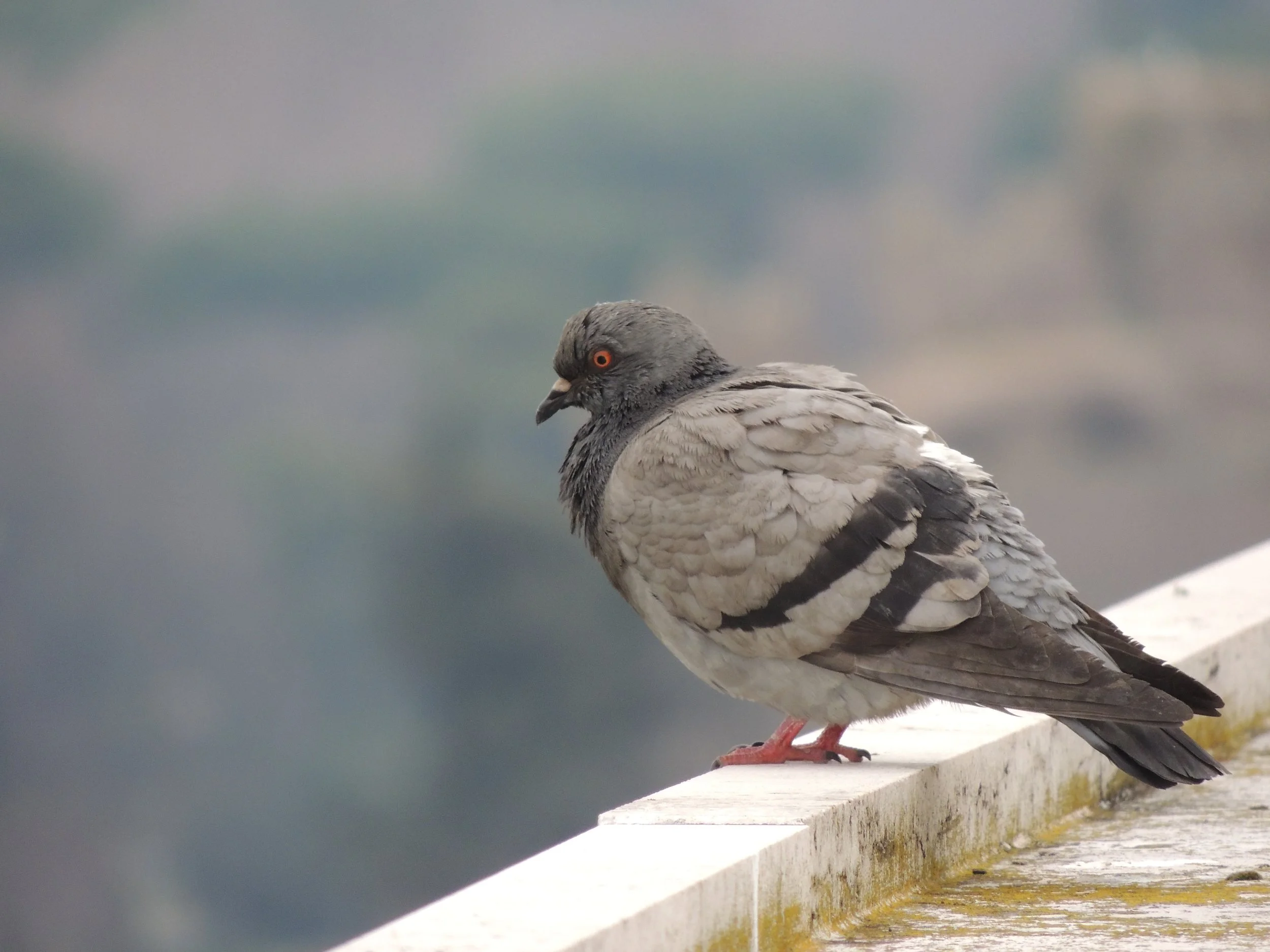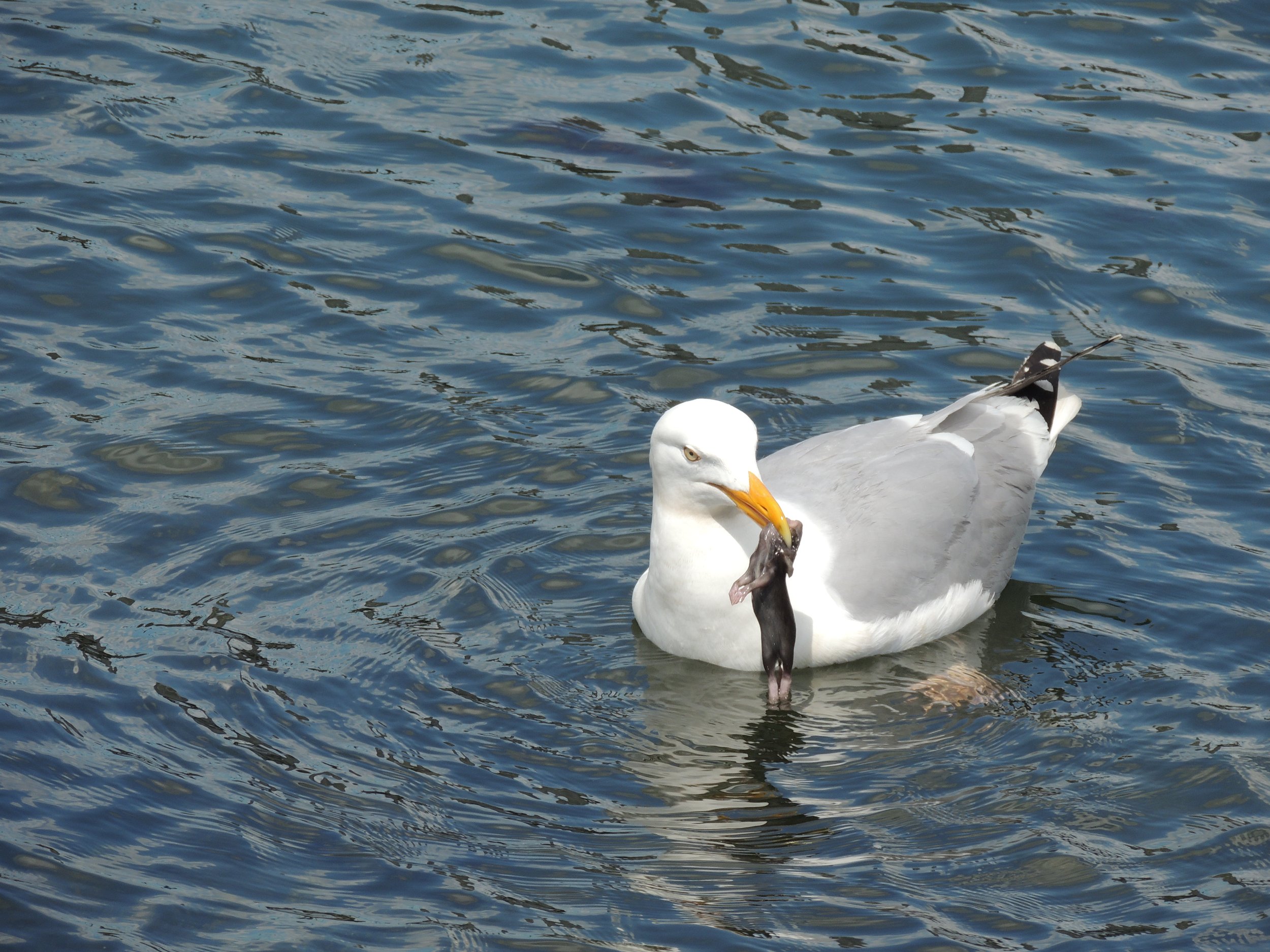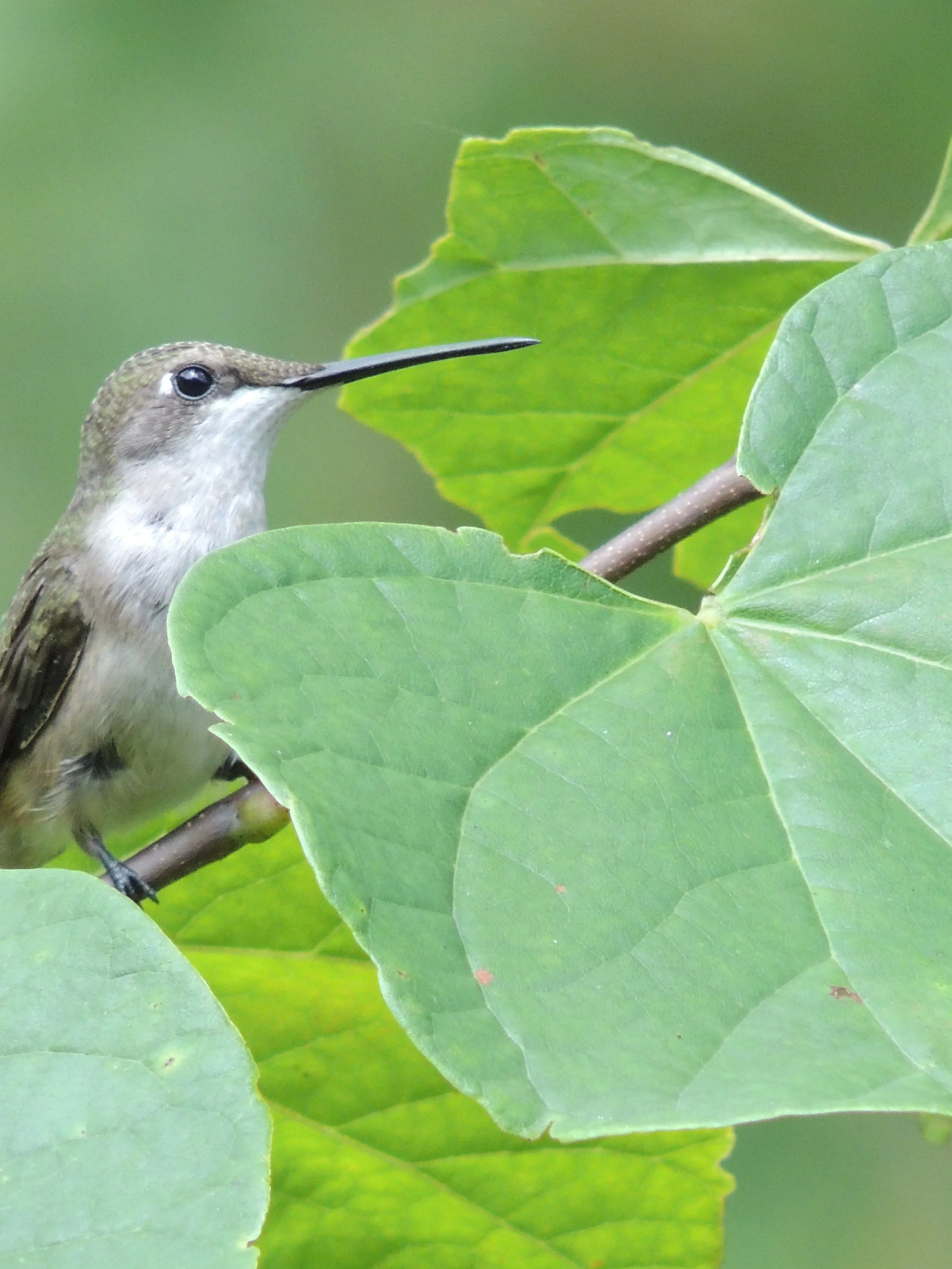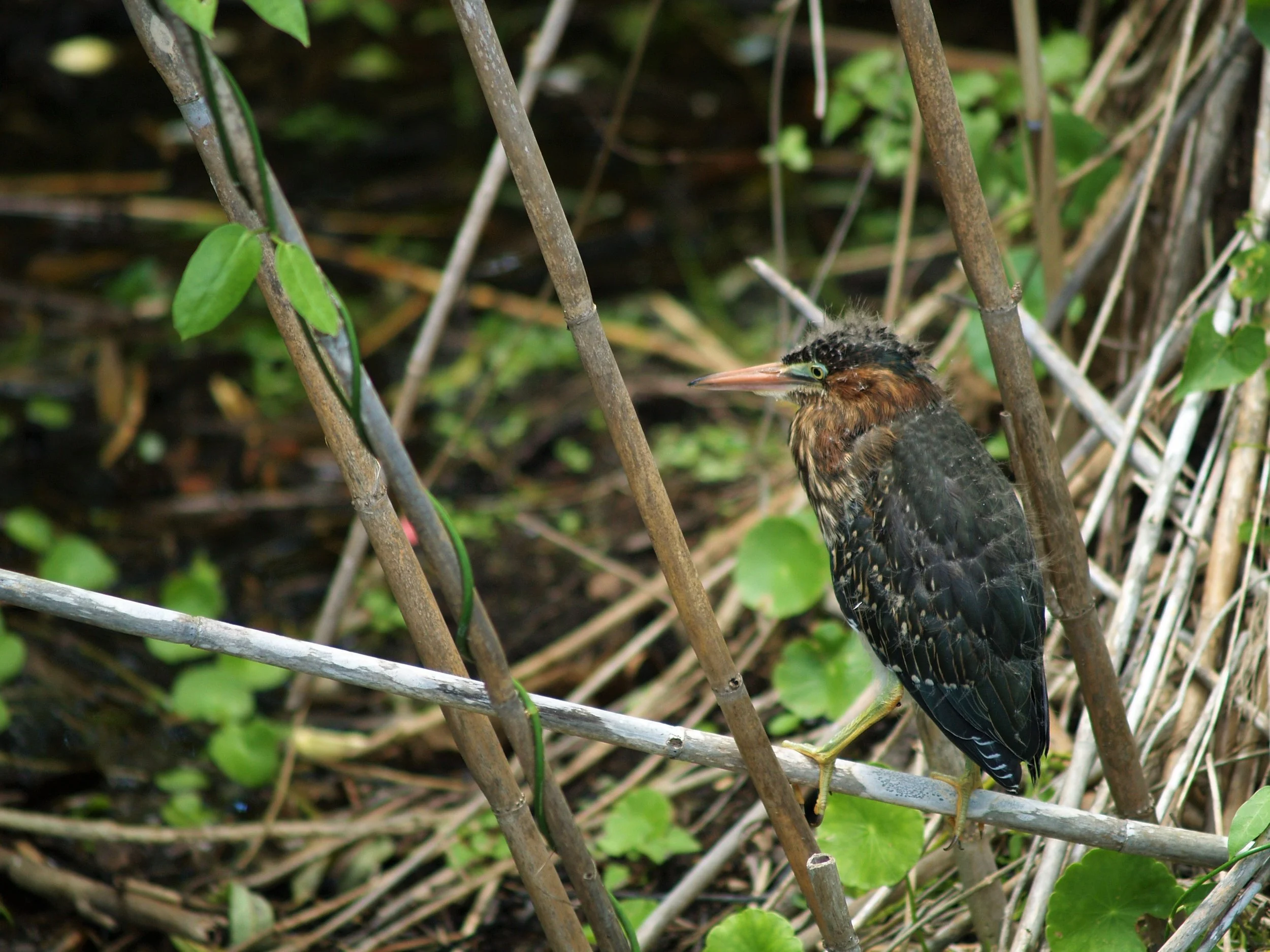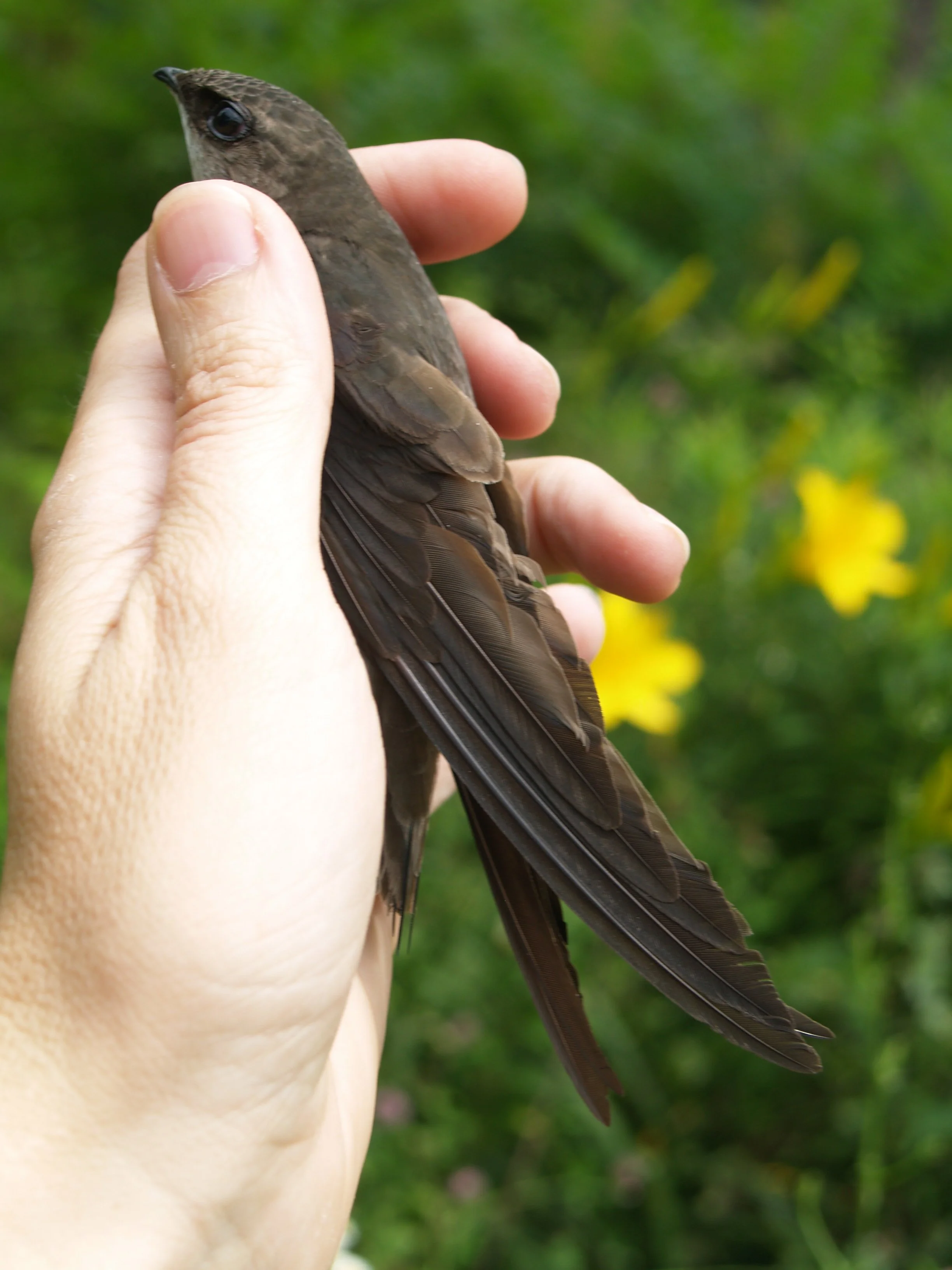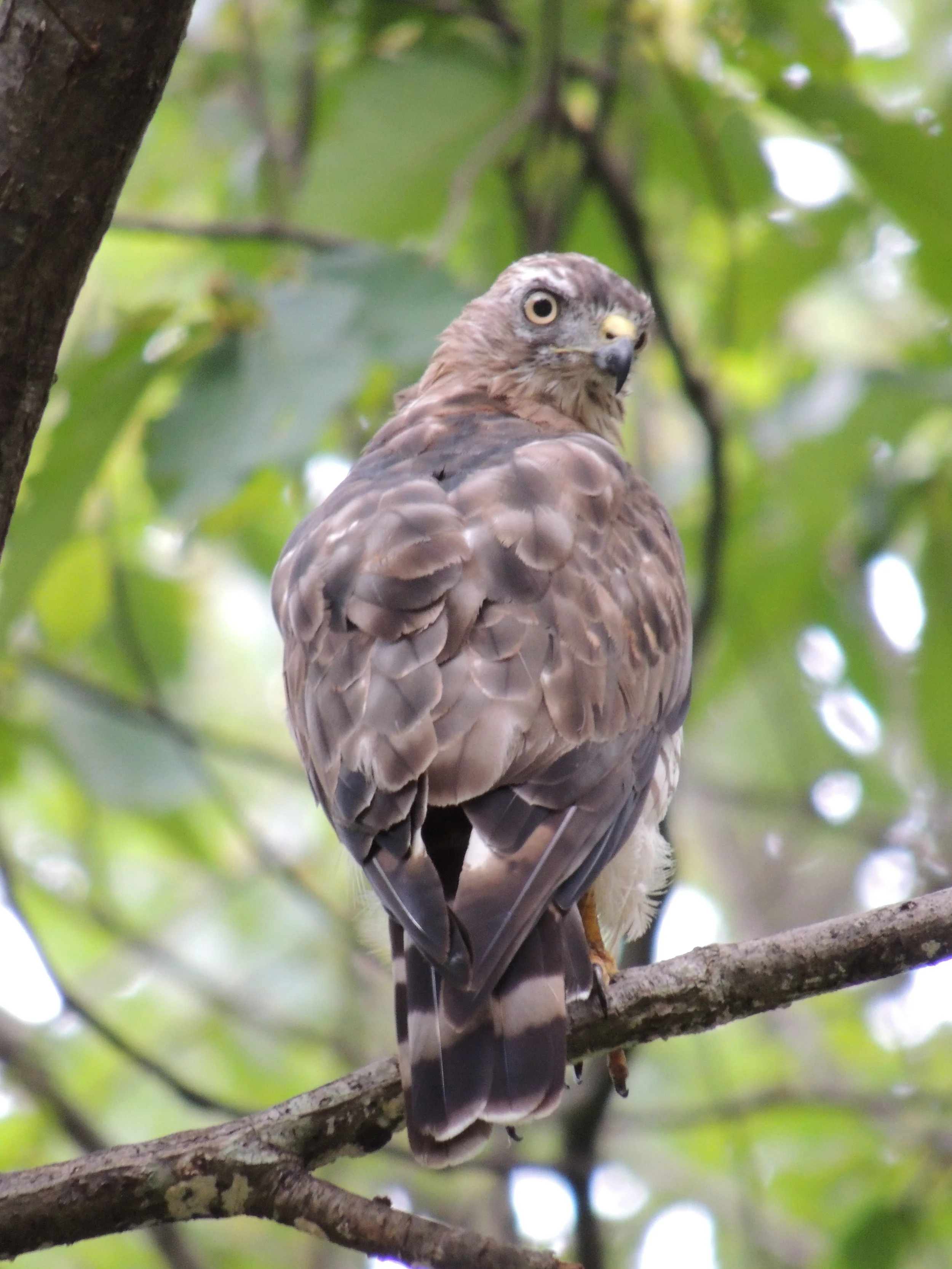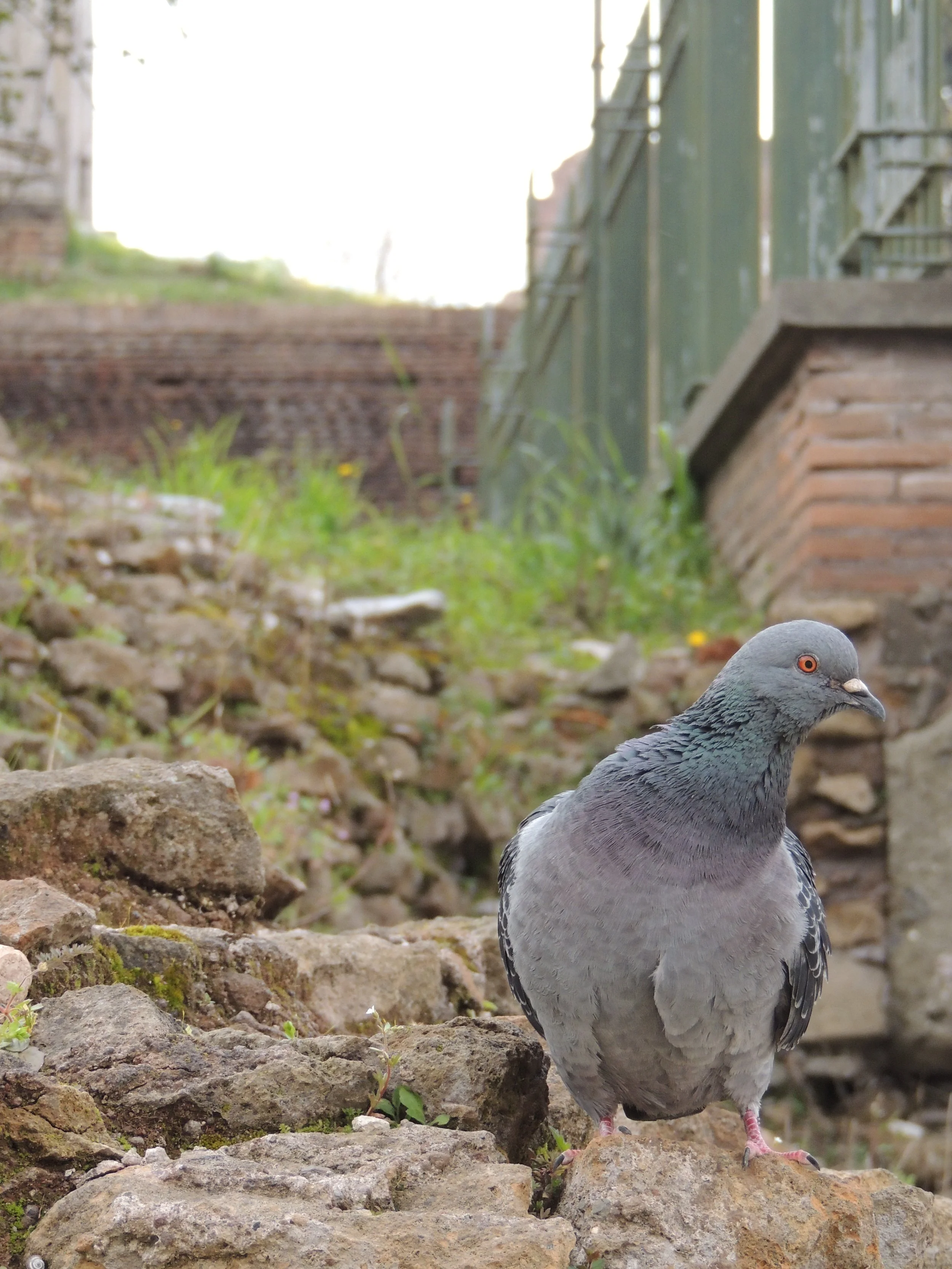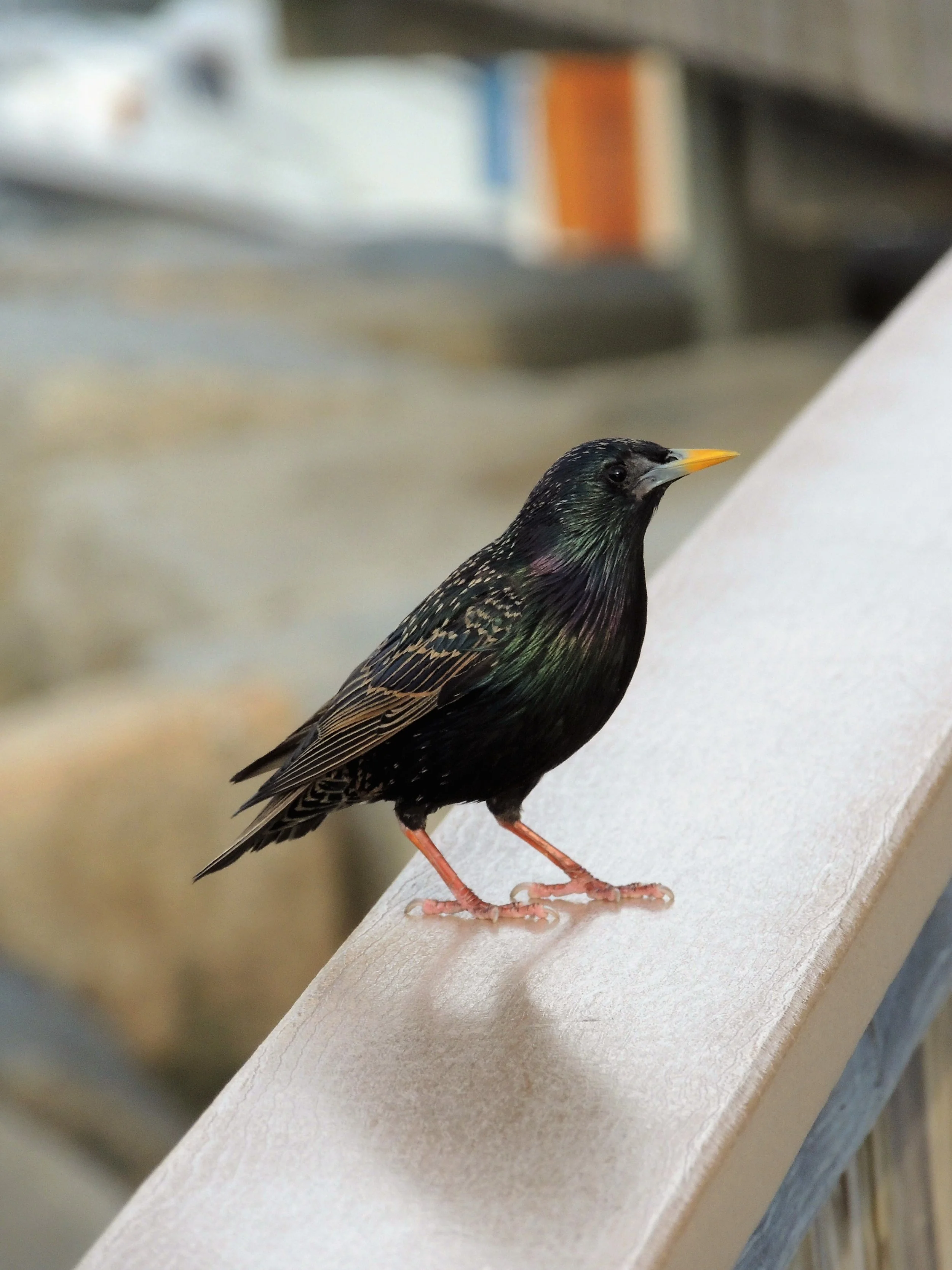Rock dove (Columba livia)
Photo: Jamie K. Reaser
Biophilic Cities Are for the Birds
By Jamie K. Reaser
April 2025
When people think of urban birdlife, the images that come to mind are typically of flocks of portly pigeons rushing around on concrete or asphalt to gobble bits of bread tossed to them by an old lady in tennis shoes sitting on a graffitied park bench. Maybe they recollect savoring an exotic dark roast and managing a cheesy omelet outside a café, at a cozy red-and-white-check clothed table, on one of the first nice weekends of the year, while European starlings milled about, hoping for a fork to make a clumsy plate-to-mouth food delivery. Of course, it’s also possible they remember the time they witnessed a host of English house sparrows land on the table next to them - the one that had just been vacated by a charming couple – and feverishly work the crumby scene before the tip-famished waitress returned.
Herring gull (Larus smithsonianus) eating a rat in the Boston Harbor
Photo: Jamie K. Reaser
But there’s more to it.
At least 20% of the world’s bird species occur in urban areas (Aronson et al. 2014). Peregrine falcons (Falco peregrinus) raise their broods on skyscraper roofs and sills. Chimney swifts (Chaetura pelagica), the infamous “flying cigars,” twitter on high, narrating erratic wing beats as they pluck errant flies and beetles and such mid-air. Gulls of various species-per-geography cackle at the urban-river fringe, coursing above the waters where great egrets wade and strike for what swims-and-can-be-swallowed. Dainty warblers drop down from cultivated trees into fountains to sip.
On Saturday, May 10, World Migratory Bird Day (WMBD) is going to be a day for celebrating city birds and the communities of which they are a vital part. The official theme is Shared Spaces: Creating Bird-Friendly Cities and Communities. Birds and people can co-exist, and thrive.
In 1993, WMBD was launched by the Smithsonian Migratory Bird Center and Partners in Flight-Aves de las Americas (coordinated by the National Fish and Wildlife Foundation) as International Migratory Bird Day – a Western Hemisphere celebration of migratory birds and the phenomenon of migration. Twenty-five years later, the event went global. Under the auspices of Environment for the Americas, WMBD celebrations now take place along all major migratory bird corridors: the African-Eurasian flyway, the East Asian-Australasian flyway, and the Americas flyway.
Ruby-throated hummingbird (Archilochus colubris)
Photo: Jamie K. Reaser
Sing it: Loud and Clear
The human voices that sing out on WMBD amplify what the birds need – everywhere they go. In 2025, the unified message is that human communities can play a significant role in supporting migratory birds – in cities and beyond. Biophilic human environments are bird-friendly. Perhaps, urban birds can also make cities more human-friendly. In his 2021 book, The Bird-Friendly City: Creating Safe Urban Habitats, Tim Beatley refers to bird-friendly urban environments as high in “birdicity” qualities, guiding the reader through examples of how urban environments can be planned and modified to better support our feathered friends (Beatley 2021, Box 11-1). It’s clear from the narratives about his own urban bird experiences that Beatley has benefited, as a person, because of city birds.
WMBD 2025 offers the following nine key messages:
1. Whether in the city or the countryside, all communities can support migratory birds by adopting bird-friendly practices. These include creating bird-healthy habitats (e.g., free of invasive species), implementing measures to keep birds from hitting windows, reducing pollution, and providing ample native plant food sources for birds.
2. Urban expansion can lead to habitat loss if not well planned. Habitat loss is a leading factor in the decline of bird nesting and feeding areas, as well as food sources and shelter. It jeopardizes migratory bird survival.
3. Non-native species of plants and animals (esp. free-ranging cats) that become ecologically harmful can decimate bird populations. Many of these invasive species compete for resources that birds need to survive, others are bird predators, and some spread diseases that are fatal to birds.
4. Fatal collisions with buildings and glass are worsened by light pollution from city structures, reflections that confuse birds, and frameless building designs. Foggy and rainy weather makes visibility even more difficult for birds flying through the thick of it. There is a need for urban architects and city planners to think like birds – to become bird brains.
5. We can be bird-friendly people. We can work together to improve the safety of our cities and communities for birds. By collaborating with neighbors, schools, local officials, and community organizations, we can help people learn about migratory birds, inspire them to be good urban bird stewards, and come together to create cities high in birdicity qualities.
6. Sustainable city planning prevents urban sprawl and creates interconnected green (land) and blue (water) spaces that provide essential habitats for migratory birds to feed, nest, and find shelter. Bird-friendly biophilic design needs to be applied to adapt existing urban infrastructure and plan future cities from the ground up.
7. Global cooperation and collaboration are essential. Just as birds migrate across borders, we need to work together internationally, creating places for birds to rest and feed (stopover) along the entirety of their migratory routes. Some will stay in cities for a season, others are just tourists passing through.
8. We need to bring nature back into our cities and communities by reintroducing native plants and by adapting development to better support natural environments. Parks, nature trails, and water features can benefit birds and people.
9. We all have a part to play in supporting migratory birds! We can come together to create shared spaces in which birds and people thrive.
Green heron (Butorides virescens)
Photo: Jamie K. Reaser
Chimney swift (Chaetura pelagica)
Photo: Jamie K. Reaser
Broad-winged hawk (Buteo platypterus)
Photo: Jamie K. Reaser
Do it: For the Birds
The Shared Spaces theme promotes seven actions you can take to create bird-friendly spaces…to foster an even more biophilic city:
1. Plant native: The plants native to your community provide birds with vital food and shelter. Remove invasive plants that can poison birds and/or compete with native plants (Tallamy 2025).
2. Dim the lights at night: The glow from artificial lighting can disrupt bird activity patterns, alter their migration processes, and lessen breeding success (Cabrera-Cruz et al. 2018).
3. Make windows visible: Birds collide with windows that reflect their surroundings or are not visible (Brown et al. 2021). Dull reflections and place objects on windows so the birds avoid airstrikes.
4. Protect insects: Birds eat what bugs them. Most birds depend on insects at some time during their life cycle (Tallamy and Shriver 2021). Avoid using pesticides and other chemicals that contribute to the declining numbers of butterflies, dragonflies, and other insects (Goulson 2019).
5. Restrain your pets: We love our pets, yet free-roaming cats and dogs can disturb and even kill birds (Loss et al. 2013, Ramos-Rendón et al. 2023). Provide a catio (indoor-outdoor cat pen), leash your pets, and entertain them indoors.
6. Be the solution to plastic pollution: Plastic waste can kill birds through ingestion and strangulation (Wang et al. 2021). Say “no” to plastics by reusing shopping bags, avoiding single-use plastic bottles and utensils, and purchasing non-plastic toys and decorations.
7. Purchase sustainable foods: Shade-grown coffee and chocolate protect tropical agroforests (production forests) that include native tree diversity, tree canopy, and reduced pollution that supports migratory birds where they winter (Williams et al. 2021).
How else can you be biophilic for the birds? Be creative.
What’s Next?
Of course, migratory birds…migrate…so you’ll have another opportunity to celebrate Shared Spaces as these remarkable avian species head south once again. Mark your calendars for Saturday, October 11, and start planning your bird-friendly, biophilic city celebration.
Rock dove (Columba livia)
Photo: Jamie K. Reaser
European starling (Sturnus vulgaris)
Photo: Jamie K. Reaser
References and Further Reading
The key messages and actions in the article are adapted from the WMBD 2025 event planning guidelines. For more information on WMBD and to obtain 2025 event planning resources, visit https://www.migratorybirdday.org
Aronson, M.F.J., La Sorte,F.A., Nilon, C.H., et al. (2014). A global analysis of the impacts of urbanization on bird and plant diversity reveals key anthropogenic drivers. Proceedings of the Royal Society B. 281:20133330. http://doi.org/10.1098/rspb.2013.3330
Beatley, T. (2021). The Bird-Friendly City: Creating Safe Urban Habitats. Island Press, Washington, DC.
Brown, B.B., Santos, S., Ocampo-Peñuela, N. (2021). Bird-window collisions: Mitigation efficacy and risk factors across two years. PeerJ. 9:e11867. https://doi.org/10.7717/peerj.11867.
Cabrera-Cruz, S.A., Smolinsky, J.A. and Buler, J.J. (2018). Light pollution is greatest within migration passage areas for nocturnally-migrating birds around the world. Science Reports 8:3261. https://doi.org/10.1038/s41598-018-21577-6
Goulson, D. (2019). The insect apocalypse, and why it matters. Current Biology 29:R967-R971. https://www.sciencedirect.com/science/article/pii/S0960982219307961
Loss, S., Will, T., and Marra, P. (2013). The impact of free-ranging domestic cats on wildlife of the United States. Nature Communications 4:1396. https://www.nature.com/articles/ncomms2380
Ramos-Rendón, A.K., Gual-Sill, F., Cervantes, F.A. et al. (2023). Assessing the impact of free-ranging cats (Felis silvestris catus) and dogs (Canis lupus familiaris) on wildlife in a natural urban reserve in Mexico City. Urban Ecosystems 26:1341–1354. https://doi.org/10.1007/s11252-023-01388-y
Tallamy, D.W. (2025). How Can I Help? Saving Nature With Your Yard. Timber Press, New York. https://homegrownnationalpark.org/product/how-can-i-help-saving-nature
Tallamy, D.W. and Shriver, G.W. (2021). Are declines in insects and insectivorous birds related? Ornithological Applications 123:duaa059. https://doi.org/10.1093/ornithapp/duaa059
Wang, L., Nabi, G., Yin, L. et al. (2021). Birds and plastic pollution: recent advances. Avian Research 12:59. https://doi.org/10.1186/s40657-021-00293-2
Williams, A., Dayer, A.A., Hernandez-Aguilera, J.N., et al. (2021). Tapping birdwatchers to promote bird-friendly coffee consumption and conserve birds. People and Nature 3: 312–324. https://doi.org/10.1002/pan3.10191
Author
Jamie K. Reaser, Smithsonian National Zoo & Conservation Biology Institute, Front Royal, VA USA. Dr. Reaser co-founded World Migratory Bird Day.

